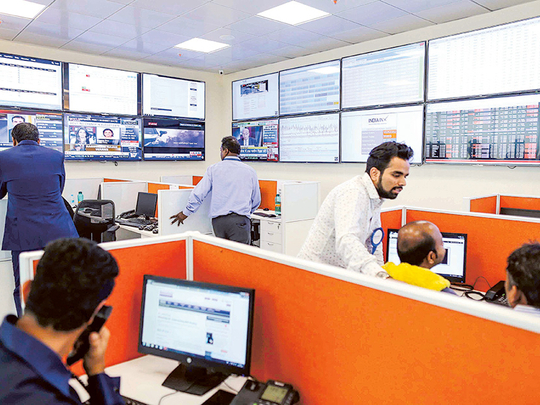
Mumbai: Overseas investors are in a bind: Bank of America Merrill Lynch estimates it will take at least until September to gauge the earnings-growth potential of Indian companies given jolts on the policy front, yet the nation’s benchmark index is among Asia’s best performing this year.
The S&P BSE Sensex has advanced 4.1 per cent in February as offshore fund managers ended four months of sales to invest a net $1.4 billion (Dh5.14 billion) in local stocks. The “big money” is still awaiting clarity on the impact of a liquidity crunch after the government scrapped 86 per cent of currency bills in November, said Deepak Ramachandra, the Mumbai-based head of institutional equity sales at Bank of America Merrill Lynch. There’s also the roll-out of a nationwide sales tax — scheduled for July 1 — to contend with, he said.
“There is a creeping feeling among foreign investors of being left out, and that if they don’t participate now, the markets are going to run away from them,” said Ramachandra. Still, he said, “till they see earnings and top-line growth reviving, India is not going to see the big money coming in.”
Local investors drove a rebound in the benchmark index from a six-month low in November, helping the market withstand a record exodus of foreign money in the final quarter of last year. That resilience, along with forecasts for India’s economy to continue as one of the world’s fastest growing, makes the market hard to ignore despite the cloud over company earnings.
Overseas investors pulled a record $4.6 billion out of Indian equities in the three months that ended December 31 amid demonetisation and the election of President Donald Trump. They net sold another $6.4 million in January, before changing tack, data compiled by Bloomberg show. Domestic funds were buyers for six months through January, including a record Rs138 billion ($2.1 billion; Dh7.58 billion) of purchases in November.
“The January-March quarter is going to be crucial,” said Ramachandra.
BofAML estimates that earnings at India’s top companies will rise 12 per cent in 2017, with nearly half of that driven by financial firms. The Sensex will probably end the year at 29,000, just 0.6 per cent away from Monday’s close, the bank forecasts. It has climbed 8.2 per cent since December 31. The benchmark gauge was little changed on Tuesday.
Overseas investors would look to invest in financial companies, mainly banks, as they assess the impact of the banknote ban, Ramachandra said. They expect the government’s steps to bring more people into the banking system, lower borrowing costs and a pick-up in loan growth, mainly from retail customers, he said.
Private banks are better than their state-run rivals, where souring loans are impacting the ability to lend, Ramachandra said. Small- and mid-cap companies in the consumer discretionary and alternative energy space would also be good picks, he said.
Foreigners are also wary of the implementation of a new national sales tax, which will replace a web of levies that delay trade traffic, increase costs and discourage compliance. While the reform has been lauded by investors, Ramachandra estimates that implementation will hit company earnings a quarter before and after.
“The quarter before is natural because, obviously, with new slabs and the new rates coming in, people will hold back production,” he said. “The quarter after, as people figure out the ropes and put their systems in place.”
Earnings surprise
Indian companies may, of course, adapt quickly to all the changes. The combined net income of NSE Nifty 50 companies climbed 19 per cent from a year earlier, while sales increased 6 per cent, in the October-December period despite the demonetisation shock. Thirty-two of the 50 companies beat or matched estimates, Bloomberg data shows.
Given the uncertainties, Ramachandra expects foreign allocation to be mainly in large-cap companies as the Sensex is “neither cheap, nor expensive,” trading at about 16 to 16.5 times its projected 12-month earnings. The options for offshore investors are also limited as few companies meet the market capitalisation, liquidity and corporate governance benchmarks required for investment, he said.
“There is more money chasing a limited number of stocks and that will continue to lead the headline indices higher,” Ramachandra said.












